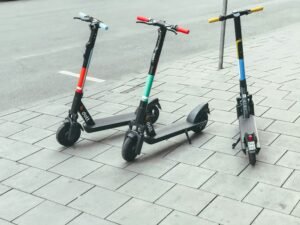
Welcome to the world of smooth scooter braking! In this article, you will uncover the secrets to mastering the art of bringing your scooter to a safe and seamless stop. From proper hand positioning on the brake lever to understanding the importance of weight distribution, you will learn all the tips and tricks to ensure a smooth ride every time. So grab your helmet, hop on your scooter, and get ready to unlock the secrets of smooth braking! Have you ever struggled with braking smoothly on your scooter? Maybe you feel a jolt every time you hit the brakes, or perhaps you’ve had some close calls because of jerky stops. Fear not, as this article will help you unlock the secrets to achieving smooth and safe scooter braking. Let’s dive in!

This image is property of images.pexels.com.
Check out our product reviews!
Understanding the Basics of Scooter Braking
Braking on a scooter may seem straightforward, but there are essential concepts you need to grasp to make the process smooth and efficient. From understanding how your scooter’s braking system works to knowing the difference between front and rear brakes, this section will cover all the basics you need to know.
When you squeeze the brake lever on your scooter, you activate the braking system, which slows down or stops the scooter’s movement. Scooters typically have two main types of brakes: drum brakes and disc brakes. Drum brakes work by pressing brake shoes against the inside of a drum to create friction and slow down the scooter. On the other hand, disc brakes use calipers to squeeze brake pads against a disc attached to the wheel, creating friction and stopping the scooter.
The Importance of Front and Rear Brakes
Front and rear brakes play different roles in slowing down your scooter. The front brake is more effective at stopping the scooter quickly because it bears more of the braking force due to weight transfer during deceleration. On the other hand, the rear brake helps stabilize the scooter and prevents skidding when used in conjunction with the front brake.
Understanding how to utilize both brakes effectively is crucial for achieving smooth and controlled stops. Remember that abrupt braking with only one brake can cause instability and potential accidents.
Tips for Achieving Smooth Scooter Braking
Now that you have a foundational understanding of scooter braking, let’s delve into some practical tips to help you brake smoothly and safely every time you ride. Whether you’re a beginner or an experienced rider looking to refine your braking technique, these tips will make a significant difference in your scooter-riding experience.
Gradual Braking Pressure
One of the most common mistakes riders make is applying too much brake force too quickly, resulting in jerky stops and potential loss of control. Instead, aim to apply gradual and consistent pressure on the brakes to slow down smoothly. Start by squeezing the brakes lightly and increase the pressure as needed, depending on the speed and distance you need to stop.
Practice Emergency Stops
While smooth and gradual braking is essential for everyday riding, practicing emergency stops is equally crucial for your safety on the road. Find a safe and open space where you can practice sudden stops at different speeds. Remember to use both front and rear brakes simultaneously while maintaining control of the scooter. By honing your emergency braking skills, you’ll be better prepared to handle unexpected situations on the road.
Use Engine Braking
In addition to using your scooter’s brakes, you can utilize engine braking to help slow down the vehicle smoothly. Engine braking involves downshifting gears to allow the engine’s compression to slow down the scooter. By downshifting gradually as you decelerate, you can reduce the workload on your brakes and achieve smoother stops.
Maintain Proper Braking Distance
Maintaining a safe braking distance from other vehicles and obstacles is crucial for avoiding rear-end collisions and ensuring smooth stops. As a general rule of thumb, leave at least two seconds of following distance between you and the vehicle in front of you. Increase this distance in adverse weather conditions or when riding at higher speeds to allow for sufficient braking time.
Check and Adjust Brake Tension
Regularly inspecting and adjusting the tension of your scooter’s brakes is essential for optimal performance. If you notice that the brake lever feels loose or the brakes are not engaging smoothly, it may be time to adjust the tension. Consult your scooter’s manual for instructions on adjusting brake tension or seek assistance from a professional mechanic to ensure your brakes are in top condition.

This image is property of images.pexels.com.
Check out our product reviews!
Overcoming Common Braking Mistakes
Even with proper knowledge and practice, riders can still make common braking mistakes that compromise their safety and riding experience. In this section, we’ll address some of the most prevalent braking errors and how you can overcome them to become a more confident and skilled scooter rider.
Riding the Brakes
One of the most frequent mistakes riders make is riding the brakes, which involves continuously applying light pressure on the brakes even when not actively slowing down. Riding the brakes not only wears down your brake pads faster but also increases the risk of overheating, leading to decreased braking effectiveness. To avoid this mistake, develop the habit of releasing the brakes when not needed and applying them only when you intend to slow down or stop.
Panic Braking
Panic braking occurs when a rider abruptly squeezes the brakes in a sudden and uncontrolled manner, usually in response to a perceived threat or danger. This impulsive reaction can result in skidding, loss of control, and potential accidents. To overcome panic braking, remain calm and focused in stressful situations, and practice emergency braking techniques to build confidence and muscle memory in handling sudden stops.
Ignoring Brake Maintenance
Neglecting regular brake maintenance and inspections can lead to decreased braking performance and safety hazards. Over time, brake pads wear out, brake fluid levels may decrease, and brake calipers can become misaligned, affecting the overall braking system’s effectiveness. Prioritize routine brake checks, including pad wear, fluid levels, and caliper alignment, to ensure your brakes are always in optimal working condition.
Underestimating Wet Weather Braking
Braking in wet or slippery conditions requires a different approach than in dry conditions due to reduced traction and increased stopping distances. Many riders underestimate the impact of wet weather on braking performance and fail to adjust their technique accordingly. To overcome this challenge, reduce your speed, apply brakes gently and gradually, and increase your following distance to allow for safe stops on wet roads.
Conclusion
Congratulations! You’ve now unlocked the secrets to achieving smooth and safe scooter braking. By understanding the basics of scooter braking, mastering essential techniques, and overcoming common braking mistakes, you’ll become a more confident and skilled rider on the road. Remember to practice consistently, prioritize safety, and always be mindful of your surroundings to enjoy a smooth and stress-free scooter-riding experience. Happy riding!


